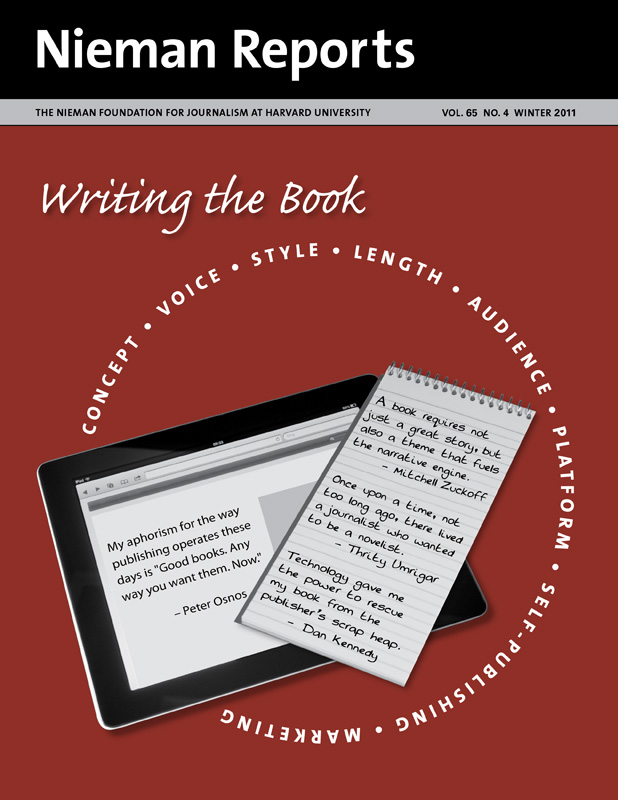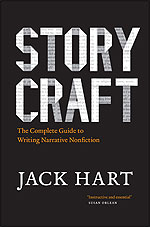I stumbled upon Jack Hart’s new narrative writing guide at the same time I was preparing to return to the classroom for the first time in seven years. I was also two months into reporting a 130-inch narrative, about a troubled Iraq War veteran who committed “suicide by cop,” for a newspaper series on post-traumatic stress disorder (PTSD). Though I haven’t written a book—and don’t have one under way—Hart’s hints about writing stories seem as apt to that longer endeavor as they are to my present-day ones.
For me, his book’s appearance was fruitful timing, not unlike finding a new recipe the morning of a dinner party and realizing all the ingredients are in your pantry. Hart’s “Storycraft: The Complete Guide to Writing Narrative Nonfiction” fortified me. It underscored lessons I thought I’d already mastered, prompting me to think deeper—and talk to my editors more—about the importance of theme.
In his introduction, Hart promises “help, not literary hairsplitting.” Retired from his job as The Oregonian’s longtime narrative writing guru, he shares behind-the-scenes stories accrued from his career working with Pulitzer Prize-winning reporters. He seems to have dissected every important narrative written in the past century and sat in on every major writing conference.
All of my journalism action heroes are present, spouting some of my favorite journalism-isms. There is Bill Blundell, telling me to digress often but not for too long; Tom Wolfe with his status details; Anton Chekhov with the rifle that better damn well fire; and Jon Franklin with his formula that cliché + theme = universal truth. Elmore Leonard sets the bar for juicy, page-turning prose by declaring that we should “leave out the parts that people skip.” But when to digress and what exactly to skip?
Hart takes the long view, citing an astonishing breadth of examples—plays, radio stories, screenplays, nonfiction books, and copious newspaper articles spanning an array of length, subject and style. He quotes from Aristotle to Ira Glass, from Michel de Montaigne to John McPhee. He sits at the feet of the masters, giving you Jim Collins’s advice on mapping a narrative arc and Nora Ephron’s on divining theme (“All storytelling is a Rorschach”).
But Hart’s passion shines brightest, and his writing flows the most seamlessly when he reveals the story behind the stories he personally edited. He describes the elements of short-story narrative by deconstructing classical music critic David Stabler’s tale of what happened when an injured pianist couldn’t perform Sergei Rachmaninoff’s Third Piano Concerto and a last-minute fill-in was flown in to replace him, nailing a thrilling standing ovation performance.
Richard Read wrote about the “The French Fry Connection” for the Fall 2000 issue of Nieman Reports. He takes readers behind the scenes of an explanatory narrative by Richard Read that follows the course of a potato from a farm in Moses Lake, Washington to a serving of French fries at a Singapore McDonald’s—by way of some rioting Indonesians and Chinese farmers. The Pulitzer Prize-winning story explains the impact of globalization with entertaining and painstakingly crafted story lines that show how increasingly entwined our global economy is. Hart describes the French fry saga—an example of meta-journalism at its finest—in ways that cleverly demonstrate his own explanatory narrative formula of alternating scenes and digressions.
The graduate students in my literary journalism course span a wide range of experience, from a published essayist to a radio reporter to a plastic surgeon who earns more than the rest of us combined yet still longs to see his name in print. (He’d read all the books before class began.) They appreciate Hart’s friendly, avuncular tone and have absorbed many of his feature-writing tenets, such as to avoid linking verbs and passive construction.
I imagine Hart’s book, like Jon Franklin’s “Writing for Story,” will be one they will turn to repeatedly in their writing lives, absorbing its more advanced lessons as their experiences progress. I know I learn something new each time I reread Franklin’s how-to narrative-writing tome.
Reporting Ethics
From The New Yorker stories of Atul Gawande to Tracy Kidder’s “Mountains Beyond Mountains,” Hart’s bibliography is an exemplary required reading list for both the beginning and seasoned practitioner. His final chapter on ethics raises interesting real-life conundrums. He seems to agree with Read’s decision not to sort pills at the request of an overwhelmed medical team he was covering following the 2004 tsunami in Sri Lanka, arguing that the reporter’s job is to document his subject’s work without altering the reality.
The altering-reality rule isn’t one I abide by, my litmus test being: If it’s life or death, being a person comes first. Having covered the recent cholera outbreak in Haiti, I found myself sorting pills and fetching supplies in my down time. To do less also would have altered the reality; after all, I reasoned, the team would have seen me as a jerk.
I once asked The New Yorker’s Jon Lee Anderson to explain why he had helped a post-earthquake subject in Haiti find food: “Journalistic mistakes are not as important as moral and ethical mistakes,” he said. “It’s not about how I feel about myself or some code that was enacted in a hallowed chamber.” Complicated, messy stories should leave readers and reporters feeling ragged, sore and raw because that’s the way life is, he told me. “Everybody should feel a little bad afterwards.”
If I have one quibble about “Storycraft,” it’s that Hart doesn’t delve into the emotional toll that intimate journalism exacts from reporters who often straddle and occasionally cross those slippery, ethical lines. One of my students confessed that her first story profile subject—a transgendered veteran struggling with PTSD and her own felony-riddled past—got under her skin so badly that she couldn’t sleep the night after her first interview.
Spotlighting more examples from women journalists—featured only about one quarter as often as the men are in this book—might have offered different insights into the emotional landscape, and fresh narratives also would have been instructive as well as a few more examples of stories that tried but failed.
These are minor complaints, though, given how much “Storycraft” does have to teach veteran and newbie reporters alike about the craft of writing. And this is bound to serve us well, whether our assignment is due tomorrow—or in two years.
Beth Macy, a 2010 Nieman Fellow, is the family beat reporter for The Roanoke (Va.) Times and teaches literary journalism to graduate students at Hollins University.




